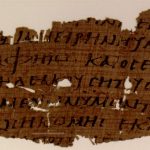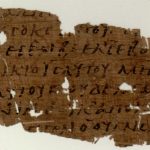| Artefact ID | 356 |
| TM ID | TM 65893 |
| Findspot (DEChriM ID) | 28 (al-Bahnasā) | Class | Textual |
| Material | Papyrus |
| Writing medium | Codex |
| Text content | Literary |
| Language | Greek |
| Description | P.Oxy. LXVI 4494; Gregory-Aland P110; Gregory-Aland 𝔓110 A papyrus fragment containing the Gospel of Matthew verses 10:13-15 and 10:25-27 with several singular readings. The text is written in a sloping, reformed documentary hand with intermittent adherence to bilinearity; see Blumell / Wayment 2015: 171. The ed. pr. describes the hand as 'handsome' and largely bilinear. The lettering is decorated with serifs, and the text is punctuated by a multiplicity of spaces and points. Additionally, the scribe used several diaereses (l. 3 and 6), breathings (rough breathings in l. 2, 6 and 7 of the verso) and apostrophes (l. 7 recto as well as l. 3 and 6 verso). The ed. pr. notes that there is only one superlinear abbreviation of a nu (αὐτη(ν) of l. 2, verso) and one occurrence of a nomen sacrum (κς in l. 2, recto; κυριός "Lord"). The scribe has also made a couple of corrections in l. 2 (recto), among which he has corrected the sigma to a zeta in Βεελ’ζεβουλ. The fragment has multiple unique readings, inter alia a genitive absolute construction that is otherwise rendered by a middle participle in the MSS (ἐξερχομένων for ἐξερχόμενοι in Matt 10:14). This construction is further developed by the 2. person plural pronoun ὑμῶν which is absent from other attestations. Other variants include ἐκμάξα[τε] (imp. "wipe!") for ἐκτινάξατε (imp. "shake!") in 10:14, an omission of ὑμῶν in 10:13a, a reversal of word order in 10:25 and a change of preposition in 10:14 from ἐκ to ἀπό, probably influenced by Luke 9:5; see Blumell / Wayment 2015: 172. |
| Selection criteria | Literary genre (Biblical), Nomina sacra |
| Date from | 300 |
| Date to | 399 |
| Dating criteria | Palaeography. Dated to the first half of the 4th c. in the ed. pr. by comparison with P.Chester Beatty I (3rd c.), P.Flor. II 108 (mid-3rd c.), and P.Oxy. XV 1778 (4th c.). The fragment is placed even earlier (first half of the 3rd c.) by Comfort 2005: 76. For the most recent date (4th c.), see Clarysse / Orsini 2012: 472. |
| Absolute/relative date | Relative date |
| Archaeological context | |
| Accession number | Oxford, Sackler Library, Papyrology Rooms, P. Oxy. 4494. |
ARTEFACT IDENTIFIERS
Editio princeps:
∙ Gonis, N., J. Chapa, W.E.H. Cockle, D. Obbink, P.J. Parsons and J.D. Thomas, et al., eds. 1999. The Oxyrhynchus Papyri, part LXVI. Published by the Egypt Exploration Society in Graeco-Roman Memoirs. London. 1-3, no. 4494, plates no. 1 and 2.
Additional bibliography:
∙ Blumell, Lincoln H. and Thomas A. Wayment. 2015. Christian Oxyrynchus: Texts, Documents and Sources. Waco, Texas. Papyrus no. 42.
∙ Clarysse, Willy and Pasquale Orsini. 2012. "Early new testament manuscripts and their dates: A critique of theological palaeography". Ephemerides Theologicae Lovanienses 88. 443-474.
∙ Comfort, Philip W. 2005. Encountering the Manuscripts: An Introduction to New Testament Paleography & Textual Criticism, Nashville, Tennessee: Broadman & Holman Publishers. 76.
∙ Comfort, Philip W. and David P. Barrett. 2001. The Text of the earliest New Testament manuscripts. Wheaton, Illinois. 115-116.
∙ Elliott, J. K. 2000. "Seven Recently Published New Testament Fragments From Oxyrhynchus." Novum Testamentum 42 (3): 209-213.
∙ Head, Peter M. 2000. "Some Recently Published NT Papyri From Oxyrhynchus: An Overview and Preliminary Assessment." Tyndale Bulletin 51 (1): 10-11.
∙ Jaroš, Karl. 2006. Das Neue Testament nach den ältesten griechischen Handschriften (CD-Rom). 3741-3749, no. 2.6.
∙ Min, Kyoung Shik. 2005. Die früheste Überlieferung des Matthäusevangeliums (bis zum 3./4. Jh.): Edition und Untersuchung. ANTF 34. Berlin / New York: Walter de Gruyter. 240-252.
∙ Wasserman, Tommy. 2012. "The Early Text of Matthew". The Early Text of the New Testament. Hill, Charled E. and Michael J. Kruger. 101-102.


 Json data
Json data





